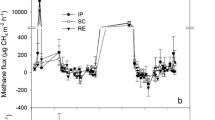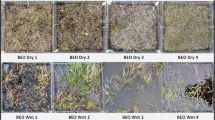Abstract
The roles of plant transport and CH4 production in controlling CH4 flux from wet meadow tundra communities were investigated. Plant transport was the dominant pathway of CH4 flux from this ecosystem. Most CH4 production (measured within situ anaerobic incubations) occurred well below the water table, and C supply (estimated by anaerobic CO2 production) was the best single predictor of CH4 production rates. Plant transport of CH4 was controlled both by CH4 supply and the plant species.Eriophorum angustifolium transported substantially more CH4 than didCarex aquatilis, due to differences in size and structure of the two species. The composition of the plant community was a greater control on CH4 flux from the site than either water table height (which varied only slightly) or CH4 production rates, indicating the importance of species-specific plant dynamics in controlling CH4 flux from arctic wetlands.
Similar content being viewed by others
References
Armstrong W (1979). Aeration in higherplants. In: Woolhouse HW (Ed) Advances in Botanical Research (pp 226–333). Academic Press, New York
Aselmann I & Crutzen PJ (1989) global distribution of natural freshwater wetlands and rice paddies, and their net primary productivity, seasonality and possible methane emissions. J. Atmos. Chem. 8: 307–358
Burke IC, Kittel TGF, Lauenroth WK, Snook P, Yonker CM & Parton WJ (1991) Regional analysis of the central Great Plains. BioScience 41: 685–692
Chanton JP & Dacey JWH (1991). Effects of vegetation on methane flux, reservoirs, and carbon isotopic composition. In: Sharkey TD, Holland EA & Mooney HA (Eds) Trace Gas Emmissions by Plants (pp 65–89). Academic Press, San Diego
Chanton JP, Martens CS, Kelley CA, Crill PM & Showers WJ (1992) Methane transport mechanisms and isotopic fractionation in emergent macrophytes of an Alaskan tundra lake. J. Geophys. Res. 97: 16,681–16,688
Flung I, John J, Lerner J, Matthews E, Prather M, Steele LP & Fraser PJ (1991) Three dimensional model synthesis of the global methane cycle. J. Geophys. Res. 96: 13,033–13,065
Funk DW, Pullman ER, Peterson KM, Crill PM & Billings WD (1994) The influence of water table on carbon dioxide, carbon monoxide and methane fluxes from taiga bog microcosms. Global Biogeochem. Cycles. In press
Gerard G & Chanton J (1993) Quantification of methane oxidation in the rhizosphere of emergent aquatic macrophytes: defining upper limits. Biogeochemistry 23: 79–97
Harden HS & Chanton JP (1994) Locus of methane release and mass-dependent fractionation from two wetland macrophytes. Limnol. Oceanogr. 39: 148–154
Moore TR & Roulet NT (1993) Methane flux: water table relations in northern wetlands. Geophys. Res. Lett. 20: 587–590
Morrisey LA, Zobel DB & Livingston GP (1993) Significance of stomatal control on methane release fromCarex-dominated wetlands. Chemosphere 26: 339–355
Morrisey LA & Livingston GP (1992) Methane emission from Alaska Arctic tundra: an assessment of local spatial variability. J. Geophys. Res. 97: 16,661–16,670
Nadelhoffer KJ, Giblin AE, Shaver GR, Murray G, Laundre J & Schimel JP (1993) Ecosystem respiration and methane fluxes in warmed and fertilized tundra ecosystems along a moisture gradient in northern Alaska. EOS 74: 151
Nouchi I, Mariko S & Aoki K (1990) Mechanism of methane transport from the rhizosphere to the atmosphere through rice plants. Plant Physiol 94: 59–66
Roulet NT, Jano A, Kelly CA, Klinger LF, Moore TR, Protz R, Ritter JA & Rouse WR (1994) Role of the Hudson Bay lowland as a source of atmospheric methane. J. Geophys. Res. 99: 1439–1454
Sass RL, Fisher FM & Harcombe PA (1990) Methane production and emission in a Texas rice field. Global Biogeochem. Cycles 4: 47–68
Schimel JP, Holland EA & Valentine D (1993) Controls on methane flux from terrestrial ecosystems. In: Mosier AR, Duxbury J & Harper L (Eds) Agroecosystem effects on radiatively active trace gasses and global climate change (pp 167–182). Am. Soc. Agronomy, Madison
Schütz H, Holzapfel-Pschom A, Rennenberg H, Seiler W & Conrad R (1989) A three year continuous record of the influence of daytime, season, and fertilizer treatment on methane emission rates from an Italian Rice paddy. J. Geophys. Res. 94: 16,405–16,416
Schütz H, Schröder P & Rennenberg H (1991) Role of plants in regulating the methane flux to the atmosphere. In: Sharkey TD, Holland EA & Mooney HA (Eds) Trace Gas Emissions by Plants (pp 29–63). Academic Press, San Diego
Sebacher DI, Harriss RC & Bartlett KB (1985) Methane emissions to the atmosphere through aquatic plants. J. Environ. Qual. 14: 40–46
Shaver GR & Billings W (1975) Root production and root turnover in a wet tundra ecosystem, Barrow, Alaska. Ecology 56: 401–410
Systat Inc. (1992) Systat for Windows, Version 5 edition. Systat, Inc. Evanston, Ill
Torn MS & Chapin FS, III (1992) Environmental and biotic controls over methane flux from arctic tundra. Chemosphere 26: 357–368
Valentine DW, Holland EA & Schimel DS (1993) Ecosystem and physiological control over methane production in northern wetlands. J. Geophys. Res. 99: 1563–1571
Whalen SC & Reeburgh WS (1988) A methane flux time series for tundra environments. Global Biogeochem. Cycles 2: 399–409
Whalen SC & Reeburgh WS (1990) A methane flux transect along the trans-Alaska pipeline haul road. Tellus 42B: 237–249
Whiting GJ, Chanton JP, Bartlett DS & Happell JD (1991) Relationships between CH4 emission, biomass, and CO2 exchange in a subtropical grassland. J. Geophys. Res. 96: 13,067–13,071
Whiting GJ & Chanton JP (1992) Plant-development CH4 emission in a subarctic Canadian fen. Global Biogeochem. Cycles. 6: 225–231
Whiting GJ & Chanton JP (1993) Primary production control of methane emissions from wetlands. Nature 364: 794–795
Wieder RK & Starr ST (1994) Organic matter quality depth profiles in northern (Ontario, Minnesota) and southern (Pennsylvania, West Virginia)Sphagnum peat deposits. Bull. Ecol. Soc. Am. Supplement 75: 248
Author information
Authors and Affiliations
Rights and permissions
About this article
Cite this article
Schimel, J.P. Plant transport and methane production as controls on methane flux from arctic wet meadow tundra. Biogeochemistry 28, 183–200 (1995). https://doi.org/10.1007/BF02186458
Received:
Accepted:
Issue Date:
DOI: https://doi.org/10.1007/BF02186458




